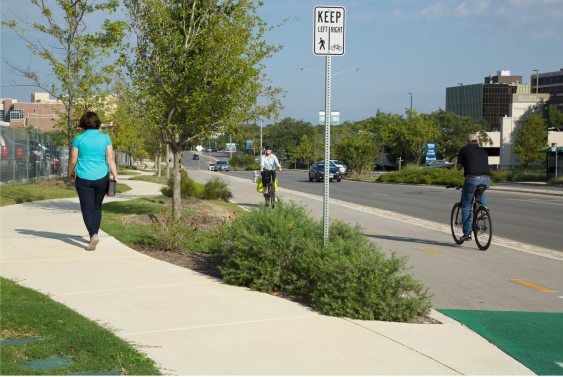A lot of research has shown a link between living in a walkable community, active transportation habits, and better health outcomes.
But what aspects of "walkability" are tied to better health? Is it the mix of uses, the connected street grid, the density of housing, or all of the above? It's an important question to understand if we want to design places that encourage healthier habits.
Researchers at St. Michael's Hospital in Toronto set out to determine what features of urban neighborhoods lead to more activity and thus better health outcomes. Their study of Toronto-area residents, published in the peer-reviewed science and medical journal PLOS-ONE, examined the link between four built environment factors and people's health records and transportation habits.
Researchers started by looking at street connectivity, population density, residential density (which measures occupied housing units), and "availability of walkable destinations" (a measure of non-residential uses).
They found that street connectivity was not an especially strong predictor of active transportation habits, but the other three factors were. Basically, if you live in a dense area, you are more likely to walk and bike often, and you're even more likely to get physical activity if there are a lot of destinations close to your house.
The team found that both residential density and the presence of walkable destinations were strongly predictive of residents' transportation habits, and that walking and biking trips per person seem to be linked most strongly to residential density. Even in low-residential-density areas with a high number of destinations, people were unlikely to walk or bike.
More often than not, however, the places that were densely settled also had a high number of destinations. And while both factors make pretty good predictors of how much activity residents get, the combination of the two -- places that are both dense with residences and full of other types of uses -- is especially powerful. Street connectivity was found to be a weaker predictor of travel behavior than the other measures, but was also strongly correlated with density and number of attractions.
Researchers assigned each block in the city to five quintiles -- from most to least walkable. Using available data about health and travel statistics, the study found a fairly strong pattern.
People who lived in the least walkable areas of Toronto had twice as many vehicles per household and were twice as likely to travel by car as those in the most walkable. They were also half as likely to use public transportation and one-third less likely to walk or bike for transportation.
The research also indicated a less clear-cut relationship to health outcomes. In less walkable areas, 49.7 percent were overweight compared with 41.3 percent in walkable neighborhoods. When adjusting for age and sex, people in less walkable communities also had higher diabetes rates: 11.3 percent, compared with 8.5 percent. However, while those results were consistent with other data, they fell within the margin of error, which researchers say is likely due to the small sample size.
It can be difficult in a study of this nature to separate cause from effect. Researchers were not able to control for income and education because of the way the study was designed. The authors noted that "there were few clear socio-demographic differences across quintiles apart from a higher proportion of children and seniors living in the least walkable areas, and a higher average household income, yet lower education, in the least walkable areas."






